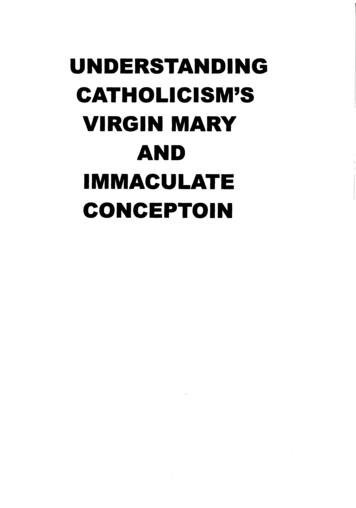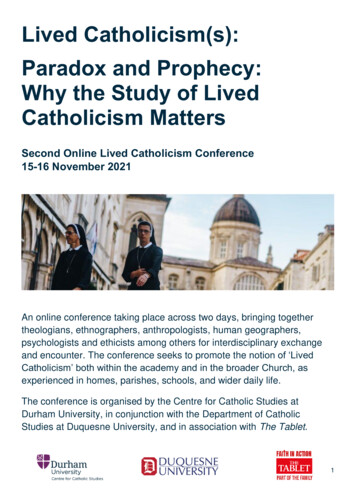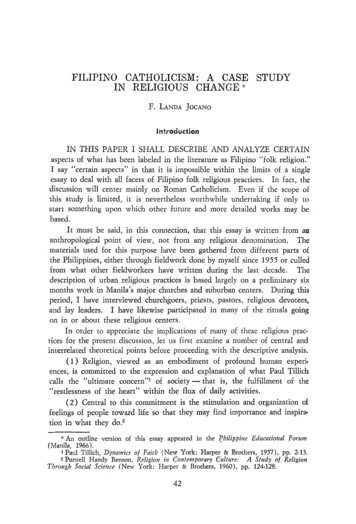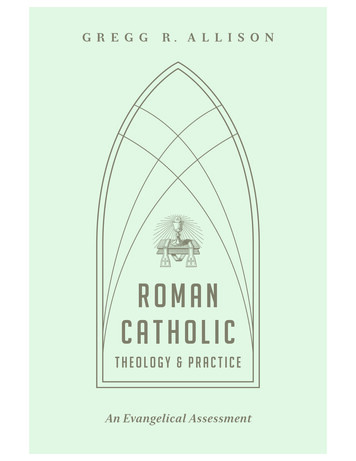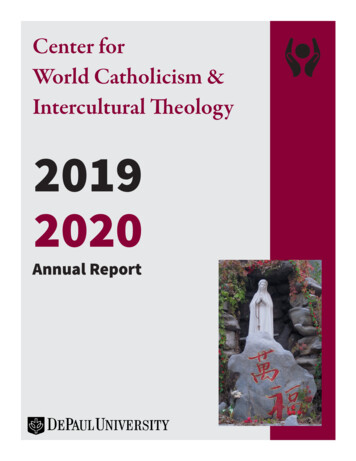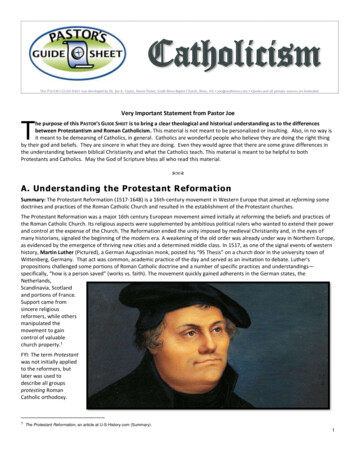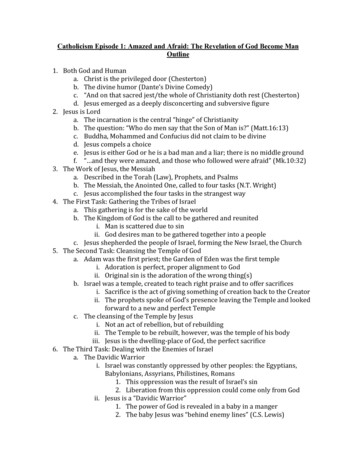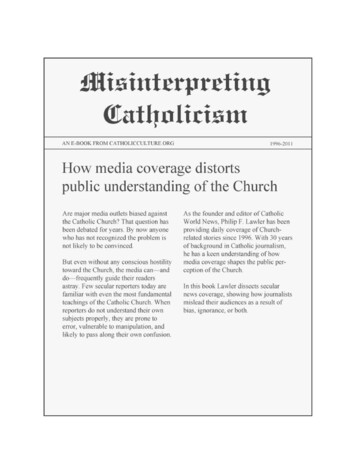
Transcription
Misinterpreting CatholicismHow media coverage distorts publicunderstanding of the Churchby Philip F. LawlerCommentary by veteran news editor Philip F. Lawler on the misunderstanding of, andbias against, the Catholic Church persistent in today’s media.Trinity CommunicationsCatholicCulture.orgP.O. Box 582Manassas, VA 20108
Copyright Trinity Communications 2011Book ID: MC-hmcdpuc-pflThe chapters of this book appeared first on the Trinity Communications website,CatholicCulture.org.Our website includes many more Catholic materials, including daily news, commentary,liturgical year resources, Church documents, reviews, and collections of historic Catholicwritings and references. You can also sign up for daily and weekly email newsletters.Trinity Communications is a non-profit corporation. If you would like to support ourwork, please register and contribute on the website; or mail a check or money orderalong with your email address to Trinity Communications, P.O. Box 582, Manassas, VA20108, USA.We look forward to seeing you at www.catholicculture.org.
Table of ContentsIntroduction6How to keep the media honest in COVERage of the Church14What the media don’t notice18Part I: What Journalists Don’t Know20Time lags in the news cycles21Another vivid illustration of the need for reliable sources of Catholic news23The religious illiteracy of secular reporting24Out of their depth25So where’s the controversy?26Indulgences and the nature of the Church28Religious illiteracy30Can a sinner become a saint? Yes. Why do you ask?31Why you need CWN: illustrated once again34Desecration of the Eucharist: a story not worth telling35Part II: When Bias Is Blatant38Brace yourself for the annual media assault on Christian orthodoxy39Debunking the ‘gospel conspiracy’ theory41Advance warning: inaccurate news reports coming soon43Of all the Rutten ideas44Worst Story of the Month Award: an early nomination46The bishops and their(?) lobbyists48Part III: When the Media Choose Sides50Anti-Catholic Catholics51Roman Catholic Womenpriests and their journalistic cheerleaders53The Pope’s message turned upside-down57Extinction, accepted in ‘the Jesuit tradition’60The argument from (anti-Catholic) authority62Part IV: None So Blind64Media malpractice65Apart from the mass killings, things are so pleasant!66The issue that won’t go away68Does abstinence cause pregnancy? The Times makes the argument69Icy Vatican reception damaging to Pelosi71
The Pope’s ‘green’ message: not standard environmentalism73Ars gratia artis77A ‘scandal’ the Vatican should love79Part V: A Story Becomes an Obsession81Why is John Paul II on trial in the media today?82Editorial misfire85The trail that doesn’t lead to the Vatican86The effort to implicate the Pope88The Pope and the Murphy case: what the New York Times story didn’t tell you90Holding the New York Times accountable92Journalists abandon standards to attack the Pope93Tough competition in the media-bias departmentAnother vicious, inaccurate, and contradictory New York Times attack on Pope96Benedict99CNN’s appalling attack on the Pope102Angry voices on both sides104Single-issue journalism106Part VI: Sniping at the Pope108‘Potential frailty’109The mounting campaign to silence the Pope111Should the Pope clarify his remarks? He already did.113The Pope’s uncivil critics114A not-so-rare mistake117Part VII: With Friends Like These119Speaking from ignorance at L’Osservatore Romano120The Welcome mat for Obama121The Vatican newspaper has betrayed the Pope123
MISINTERPRETING CATHOLICISM6IntroductionSeptember 09, 2011Every weekday morning I begin my day’s work by reading dozens of news stories aboutthe Catholic Church: primarily stories carried by secular news outlets. Sometimes thatexercise is depressing; sometimes it is hilarious. More often than not, the secular mediaprovide only partial coverage of Church-oriented stories, because more often not thanthe reporters covering those stories have only a partial understanding of Catholicism.Consequently, anyone who relies on the secular media for his news about the Churchwill have a warped understanding of Catholic life today.Is the media biased against the Catholic Church? The question has been debated fordecades now, and the argument has been presented in detail, again and again. By now,anyone who does not already acknowledge the existence of anti-Catholic bias is unlikelyto be convinced by one more presentation of the evidence.This book, however, is not dedicated to the argument that reporters and editors arehostile to Catholicism. Animosity toward the faith can certainly result in biasedcoverage, of which there are several illustrations in this volume. But even without anyconscious hostility, the media can—and frequently do—offer distorted reports for eitherone of two reasons.First, reporters who do not understand the Church often give only a partial,misleading presentation of Catholic affairs. Their editors, equally ignorant on thesubject, fail to correct them. Reporters can be misled by critics of the Church (often, alas,critics who portray themselves as faithful Catholics), who present their opinions as facts.They can be misguided themselves, by misconceptions about Catholic belief that theypicked up in childhood, or in college courses taught by professors suffering from outrightbias or the same sort of ignorance. Thus they can perpetuate errors, making them evenmore widespread.Second, reporters can simply ignore potential stories that would be of special interestto Catholic readers, or to non-Catholics who take an interest in Catholic affairs.Journalists quite naturally pay attention to the developments that are most interesting tothem, to their editors, to their friends and acquaintances. If they live in a secularizedsociety, surrounded by people who have no interest in religious affairs, they may becompletely unaware of stories that would be keenly interesting to religious readers. Thuswww.catholicculture.org
MISINTERPRETING CATHOLICISM7for example journalists might know nothing about the latest developments within thelocal pro-life movement, or among home-schooling families—not necessarily becausethey harbor a bias against those groups, but because they rarely interact with the peopleinvolved.When reporters are blatantly biased, discerning readers can learn to recognize theeditorial slant, adjust appropriately, and come away from a news story with at least arudimentary idea of what actually happened. Consider how athletic events are covered innewspapers that make no pretense of objectively in their sports pages. If you read aboutthe Ohio State-Michigan football game in the Ohio State campus newspaper, you will begiven a cheerfully partisan view; the reporter’s judgments about the game’s heroes andvillains will be very different from those found in the Michigan student newspaper. Butyou, as the reader, can probably judge for yourself which players on both teams weremost impressive. At the very least, you will know the final score.But suppose you were looking in those same campus papers for the latest news aboutyour hometown softball league. You would see nothing. The most exciting game in thehistory of that league might have been played during the past week, but you would notknow about it.And now imagine that the game coverage in that student newspaper was provided bya reporter who had never before attended a football game, and hadn’t bothered to learnabout the sport. Imagine that the story was littered with errors and malapropisms—withreferences to players who had “hit a home run” and referees who had called penalties for“hand ball” or “hooking.” Imagine that the reporter did not understand the system ofscoring in football, and wasn’t clear about the game’s final outcome.You probably have trouble even imaging such incompetence, because of course itwould never happen. No editor would ever rely on a reporter who did not understandfootball to cover a big game. And yet, even at major urban news dailies, editors routinelyassign stories on religious affairs to reporters who have no understanding of the subject.The results can be every bit as ugly, and as bewildering to readers.A reporter’s incompetence can be every bit as damaging to the reader’sunderstanding as a blatant bias. A reader who is given the facts together with a liberaldose of the reporter’s own opinions may have a better grasp on the truth than one whoreceives only a few half-digested facts. To say that media coverage of Catholic affairsoften gives a skewed picture of the Church does not necessarily imply that journalists aremalicious. Ignorance can be even more damaging.A good journalist provides his audience with not only the essential facts about astory, but also with the relevant context. Obviously, a reporter who does not know thewww.catholicculture.org
MISINTERPRETING CATHOLICISM8field cannot provide the context. Such a reporter can easily be misguided by partisansources who offer their own “context” in pre-packaged story, neatly designed to advancesome special interest. Once again, without any hostile intent on his own part, the reportercan produce a very inaccurate perspective.Again, since my regular work involves reading dozens of stories about Catholicaffairs, I see the evidence of media bias on a daily basis. My task as editor of CatholicWorld News is to give readers an accurate understanding of events that affect theChurch. Often that work entails correcting the popular errors and misconceptions arisefrom mainstream media coverage. In this book I have collected some of the corrections,complaints, and warnings that I have posted in the past several years. I hope thereby togive readers some practice in detecting when media bias is at work, and knowing how tocope with it.All of the comments that appear in this book were originally posted on the CatholicCulture site. Most of them involve news stories that were in the headlines at that time. Inorder to preserve the flavor of day-to-day commentary, I have not altered the timereferences. Each chapter is marked with the date of its original appearance, so thatinterested readers can refer back to the news of that day for further amplification on thedetails of the news stories.After two overview pieces, on the need for a distinctively Catholic approach to thenews and the common sins of editorial omission, this book is divided into seven parts:Part I: What journalists don’t knowWhen reporters do not understand stories, or do not deem them important, the results canrange from frustrating to comical. At times a secular reporter will “discover” a newsdevelopment a week or more after it has been reported in the Catholic media. On theother hand, there are times when secular reporters pick up stories from Catholic WorldNews, demonstrating the value of our news coverage.In this opening section I comment on some of the more flagrant examples ofjournalistic ignorance about Catholic—and more broadly religious—affairs. There is theAustralian reporter who blames problems on the Bishop of Rome, but doesn’t seem toknow that the Bishop of Rome is the Pope. A BBC story informs us that “Jewishtheology” prohibits murder—as if the ban on killing were some recondite theologicalpoint that only Jews would understand. The Washington Post offers a view onCatholic-Anglican affairs so thoroughly misinformed that I cannot unravel theconfusion. An ABC Nightline documentary discovers controversy where no controversyexists. A Minnesota newspaper botches a story on indulgences, and demonstrates in thewww.catholicculture.org
MISINTERPRETING CATHOLICISM9process that it does not understand the very nature of the Church. And from Floridacomes a story that perpetuates an old canard about Catholic belief regarding theEucharist. Part I also includes my commentary on an opinion column by one writer whoshould know better: a professor who “dumbs down” the understanding of Catholicteaching—deliberately, one suspects—in order to score his own partisan points.Reporters often cite “Vatican sources” or “Church officials” to confirm news stories.Such citations should be handled with extreme caution. There are quite a few peopleworking at the Vatican; few of them can speak with any authority about Church policies.The old adage is worth remembering: “Those who know, don’t talk; those who talk,don’t know.” And sometimes “those who talk” are inflating their own importance—orhaving their importance exaggerated by sympathetic friends—in order to convey theappearance of an authority they do not possess.I close Part I with my reflections on an unusual story. It was a story that involvedCatholic affairs, and won wide coverage in the secular media. Yet I was reluctant to givethe story any coverage at all, and I explain why.Part II: When Bias Is BlatantPart II covers the more conventional aspects of media bias: the stories in whichsome—an editor, a reporter, or a news source—clearly intends to criticize Churchteachings.Even here, however, ignorance can play a role. Every year, as Easter approaches, the“Jesus Seminar” comes up with some new attempt to debunk the Gospel accounts. Whenradical theologians advance new theories about the “real” teachings of Christ, mostjournalists are not equipped to find the flaws in their arguments, or even to recognizewhen they are new versions of tired old theories that lost their intellectual luster a fewcenturies ago.Part II includes my analysis of two clearly hostile columns about Catholic affairs.One is by a prominent columnist who objected to the beatification of Pope John Paul II,apparently because the Polish Pontiff did not advance his (the columnist’s) preferredviews. The other comes from a deservedly obscure outlet, which takes editorial bias tonew heights with the argument that the Catholic Church “would rather let you die thanuse a condom.”If reporters are out of their depth, and their sources are biased, the results are thesame as they would be if the reporters themselves deliberately distorted the facts.Unfortunately, sometimes these biased perspectives come from people who areemployed by bishops; in those cases, the reporters’ confusion is understandable.www.catholicculture.org
MISINTERPRETING CATHOLICISM10Part III: When the Media Choose SidesWhen controversies arise within the Catholic Church—and they arisefrequently—liberal journalists are quick to embrace the cause of liberal Catholics. In factthe nastiest criticism of the Church comes from commentators who identify themselvesas Catholics, while rejecting fundamental Church doctrines. One of the most influentialfigures in American journalism describes himself not as a lapsed Catholic but as a“collapsed Catholic,” suggesting a new level of alienation. Yet he continues to commenton Church affairs, still claiming that his perspective comes from inside the Church fromwhich he is so thoroughly estranged.If journalists followed their ordinary standards for reporting, they would quicklyrecognize that the women who claim to have been ordained as Catholic priests are notreally Catholic, and/or not really priests. But the secular media regularly defer to thesewomen, accepting the priestesses’ claims even when all the available evidence weighsagainst them.In similar fashion, reporters pounced enthusiastically on the report that PopeBenedict XVI had endorsed the use of condoms as a defense against AIDS, since ahandful of self-identified Catholics placed that interpretation on a much-misunderstoodpapal statement. A sympathetic report on the notoriously liberal Jesuit order conveyedthe curious message that the spectacular decline in the number of Jesuit recruits istestimony to the vigor of the order, rather than its self-destructive impulse. And when anArizona bishop disciplined a Catholic hospital for allowing an abortion, reportersdeferred entirely to the hospital administrators—not only on questions of medicalpractice, but even on questions of theology and canon law.Part IV: None So BlindWhat would happen if 100,000 people or more gathered in Washington for a publicdemonstration, and the major media outlets did not cover it? That’s what happens eachJanuary with the March for Life. The mainstream media ignore the pro-life movementbut consistently downplay pro-life arguments, so that a report on China’s brutal“one-child” population policy can completely overlook the cost in human lives, andreporters covering political and legal issues can be consistently surprised by the fact thatthe abortion issue has not yet disappeared. Sometimes journalists give the impressionthat their own view of the world verges on solipsism: they are slow to recognize that anidea or movement continues to exist, even if they cease to pay attention. This can applyeven to basic scientific realities; the New York Times is ready to make the preposterouswww.catholicculture.org
MISINTERPRETING CATHOLICISM11argument that abstinence causes pregnancy, since the more conventional explanation forpregnancy is a taboo subject.Reporters who were not paying careful attention failed to notice when then-Speakerof the House Nancy Pelosi visited the Vatican and received an icy reception. Vaticanofficials were sending a message to American Catholics, but that message was notreceived, because most American Catholics never heard the story.Journalists were quite happy, on the other hand, to publicize Pope Benedict’sstatements on the need to protect the environment. Still, in their coverage the media didnot notice that the views expressed by the “Green Pope” were quite different from thoseof other environmentalists. Reporters also found it newsworthy when Pope Benedict metwith artists to encourage their work. Most accounts of that meeting managed to suggestthat it is somehow unusual for the Vatican to sponsor artistic endeavors: an idea thatwould come as a surprise to Michelangelo, Palestrina, and countless others.This section of the book again ends with an offbeat item: a human-interest story thatfew media outlets noticed, but I find fascinating. It’s a story about the evening whenPope Benedict reportedly stole out of the Vatican for dinner at his favorite restaurant. Isit true? I don’t know; no one will confirm it. But I hope so.Part V: A Story Becomes an ObsessionFor the past decade, media coverage of the Catholic Church has been dominated bystories on the sex-abuse scandal. That story has been characterized by the same problemsthat appear in all other coverage of Catholic affairs, and since the volume of stories onthe scandal has been much greater, so too has the amount of misinformation.The beatification of Pope John Paul II, which should have been such a time ofcelebration for the universal Church, saw a spate of stories suggesting that the latePontiff had handled the sex-abuse scandal poorly. There are legitimate questions thatcould be asked about how Blessed John Paul responded to complaints about abusivepriests—and, perhaps more importantly, about bishops who failed to discipline thosepriests. But was this the appropriate time to ask those questions? Reporters who hadnever questioned the late Pontiff’s actions while he was alive suddenly turned to thestory. Why? Because the sex-abuse story had become the only story about the CatholicChurch that the media considered important, and the Vatican had become the primarytarget for criticism.During the year 2010, critics of the Church mounted an aggressive worldwidecampaign to persuade the public that the Vatican was ultimately responsible for theentire sex-abuse scandal. The facts did not support that criticism, but reporters coveringwww.catholicculture.org
MISINTERPRETING CATHOLICISM12the story were often unacquainted with the facts, and the Vatican’s critics were offeringonly their own special perspective. At its peak, the publicity campaign against theVatican culminated with an attack on Pope Benedict, designed to convey the impressionthat he had sought to cover up evidence of abuse—when in fact the Pope had workedenergetically to root out the corruption.Part VI: Sniping at the PopeCriticism of the Roman Pontiff is always a popular pastime, and Pope BenedictXVI—who was a controversial public figure for years before his election to St. Peter’sThrone—has been a special target. Some reporters take great pains to remind readers ofthe Pope’s advanced age; others never miss an opportunity to mention his youth inHitler’s Germany.When the Pope makes a statement that offends modern liberal sensibilities, he isvilified. His opponents do their best not to answer the Pope’s arguments, but to silencehis voice. However, even his harshest critics are willing to wrench his statements out ofcontext, when possible, and invoke the Pope’s moral authority to advance their owncauses. Finally, when the Pope makes an important public statement that catcheslisteners by surprise, there are always commentators ready to complain about what he didnot say. PartVII: With friends like theseIn an ideal world, popular misconceptions about the Catholic Church would not survivefor long; the damage done by the secular media would promptly be repaired by the workof strong Catholic outlets. Unfortunately, few Catholic outlets today have the cloutnecessary to counteract the influence of the mainstream media giants. And to makematters worse, the most visible of all Catholic media outlets—the Vatican newspaper,L’Osservatore Romano—sometimes exacerbates the problem.Under new editorial management, L’Osservatore Romano has caught the attention ofthe secular media with its sympathetic treatment of entertainment icons like MichaelJackson and the Beatles. But in the process the Vatican newspaper has trivialized its ownmessage. On more serious matters, L’Osservatore has demonstrated a sad inability torecognize the fault lines in the American political system, leading the paper into anill-advised defense of President Obama against his pro-life critics. And on onememorable occasion, at the release of a book-length interview with Pope Benedict, theeditorial treatment by L’Osservatore Romano seriously undercut the Pope’s ownmessage on a highly controversial topic. That inexplicable gaffe led me to suggest thatwww.catholicculture.org
MISINTERPRETING CATHOLICISM13the editor should resign.View this item on /commentary/otn.cfm?id 836www.catholicculture.org
MISINTERPRETING CATHOLICISM14How to keep the media honest incoverage of the ChurchJune 18, 2010In troubled times, the news is more important than ever. And we live in troubledtimes—especially for the Catholic Church.Think about it: Sometimes reading the paper or watching the newscast is a form ofentertainment. (Who’s pitching for the local team tonight?) Sometimes it’s a spectatorsport in itself. (Which Hollywood stars were divorced this week?) But often it’s a deadlyearnest activity. We follow the latest reports about a tense standoff in Korea, or agrowing oil spill in the Gulf, or an economic crisis in Greece, knowing that any one ofthose crises could have a profound effect on our own lives.The incessant pounding of criticism directed against the Catholic Church in the pastfew weeks has already had a damaging effect on the lives of the faithful. How manypeople have left the Church in disgust, influenced by stories that suggest the entireChurch is guilty for the misconduct of a few? How many lukewarm Catholics have falleninto the error of assuming that, if the media carry stories day after day hinting that thePope is orchestrating a massive cover-up of sexual abuse, the charges must be true? Howmany bishops and priests have held their tongues, fearful of speaking out about someimportant moral issue, because they fear the inevitable, scornful reply: that an institutionthat coddles child-molesters has no standing to teach morality?The teaching function of the Church is suffering because Church leaders have lostcredibility. The sanctifying function of the Church is suffering because so manyCatholics are drifting away from the faith. The governing function of the Church issuffering because dissident groups are exploiting the crisis to promote their own ideas of“reform,” looking to dismantle the structures of ecclesiastical discipline. And all thisdamage is aggravated by the pounding drumbeat of adverse publicity in the media, whichkeeps the Church on the defensive and impedes real apostolic activity.Please do not misunderstand the purpose of this column. This is not just one morecomplaint about media bias against Catholicism, nor is it a plea for silence about the veryreal misconduct of some Catholic bishops and priests. The media did the Church a greatservice by forcing the hierarchy to acknowledge the cancerous reality of sexual abuse. Ipersonally have been arguing for more than 20 years for a candid response to the abusewww.catholicculture.org
MISINTERPRETING CATHOLICISM15personally have been arguing for more than 20 years for a candid response to the abusecrisis: an end to the cover-up. I applaud reporters who handle this delicate issue honestlyand accurately.However, media coverage—of this story or any other—is helpful only if it is timelyand accurate. In the “Long Lent” of 2002, as the details of the sex-abuse scandal in theUnited States emerged in the media, the coverage was often tinged with sensationalism,but in general it was accurate and certainly it was timely. This year’s coverage, promptedby new revelations in Europe, has been neither accurate nor timely, but consistentlymisleading.Let me illustrate my point with a couple of homely examples. If you check theweather report, do you want today’s forecast, or will you settle for one that is two orthree days old? You want today’s forecast, of course. Why? Because the forecast willhelp you decide what to wear, and whether or not to plan outdoor activities. You willmake decisions and take actions based on the news you receive.Weather forecasts, unfortunately, are sometimes inaccurate. So let me take anothercase. If you have an investment portfolio, when you check the stock prices, you want thelatest quotes, not those from a week ago. At least equally important, you want accurateprice quotes. Again, based on the information you receive you may make decisions: tobuy or sell your shares.Well, today thousands of Catholics are making decisions: whether or not they cantrust their bishops; whether or not they will bother to go to Mass this Sunday. Thosedecisions will be influenced by the information they receive from the media.For most secular media outlets, religious news is not a high priority. Religious storiesare often handled by inexperienced reporters, and shunted off to the back pages of thenewspaper or the final minutes of the evening broadcast. Many newspapers confinereligious affairs to a single weekly column—sometimes with downright humorousresults. I recently spotted an item in one such weekly column, announcing that a bishophad “reportedly” been murdered in Turkey; that item was published on the day of BishopPadovese’s funeral, several days after his assailant had confessed to stabbing him. It wasan old story, dressed up as a fresh new report.Unfortunately, that is not the only old story that has been given new life by recentmedia reports. The past few weeks have seen exhaustive front-page coverage, in some ofAmerica’s most widely circulated journals, of stories that had first emerged more than adecade ago. These stories were revived not because any important new information hadbeen unearthed, but because editors found them newly marketable, in a climate of generaldistrust for the Church. The old stories were sent back out onto the media market in shinywww.catholicculture.org
MISINTERPRETING CATHOLICISM16new packages.All too often the packaging included some deceptive advertising as well. Time andagain the major media have carried stories based on ignorance or misunderstanding ofthe way the Church works.In 1996, when I launched Catholic World News, my editorial goals were based ontwo strong beliefs:First, I believed that loyal Catholics need reliable information about world affairsas seen from a Catholic perspective—and that this distinct perspective would beeven more important as the “culture wars” continued and the Church became moreinvolved in public controversies.Second, I believed that a Catholic news service would be more credible, in theeyes of the world, if it remained independent from all ecclesiastical control. No oneshould ever suspect that CWN was carrying a story—or, more ominous, coveringup a story—on orders from some chancery officeThrough the years, CWN has built up a reputation for accurate, timely reporting onCatholic affairs. While it hasn’t been easy to build up our news coverage, the investmentof time and treasure has begun to pay dividends. Our coverage doesn’t just inform CWNreaders; it informs the mass media as well.Several times in the past few weeks, I’ve noticed that large secular outlets reported astory in language remarkably close to the language of CWN stories, and explained thingsthe way CWN explained them. More than once, a major outlet has quietly corrected aninaccurate story after CWN called attention to errors. The presence of an independentCatholic outlet helps to keep the other secular outlets honest.Yet I should not leave the impression that all contact between CWN and the majormedia outlets is adversarial. On the contrary, every week I can expect a few calls fromsecular reporters who want some background information, some off-the-record guidance,some help in understanding the latest developments in Rome. Some interview requestsare more formal. This past Monday, by 11 in the morning I had been interviewed by 5different radio stations about the Pope’s homily for the closing Mass of the Year forPriests. That was an exceptionally busy day, to be sure, but it was also in indication ofhow widely the influence of the CWN news coverage c
Misinterpreting Catholicism How media coverage distorts public understanding of the Churc
